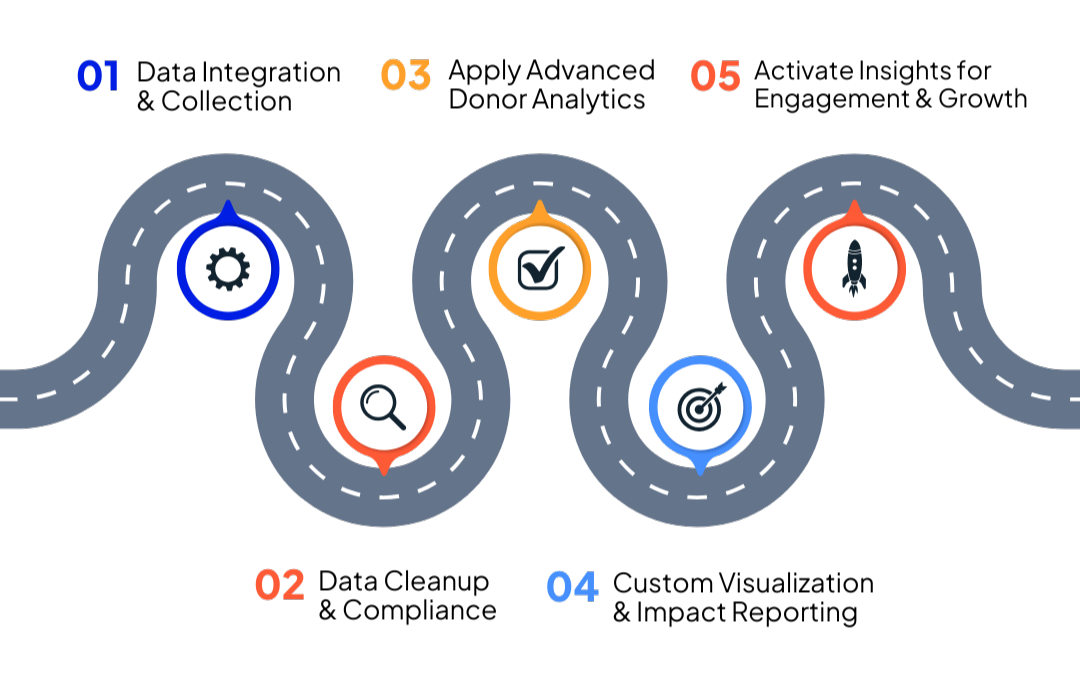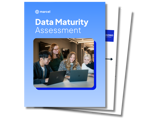A Unified Analytics Framework centralizes data from multiple systems into one cohesive structure. This allows nonprofit teams to analyze donor behavior, campaign performance, and fundraising trends more effectively.
Nonprofits manage data from a wide range of sources, including donor management systems, email campaigns, fundraising platforms, and volunteer coordination tools. Yet, despite this abundance of information, many organizations find valuable donor insights locked away in disconnected systems. The result is missed opportunities to understand and engage supporters, optimize campaigns, and demonstrate impact more effectively.
A unified analytics framework (UAF) solves this challenge by transforming fragmented data points into cohesive, actionable insights. More than just dashboards or reports, it provides a scalable structure that helps nonprofit teams make smarter, faster, and more sustainable decisions.
Marcel Digital partners with mission-driven organizations to help them harness the full potential of their data through integrated analytics strategies. The framework focuses on building alignment across systems and turning data into insights that strengthen fundraising, engagement, and long-term impact.
Core Components of a Donor-Centric Unified Analytics Framework
1. Information Model: Unifying Donor Language and Terminology
A strong information model serves as your organization’s donor language blueprint. It defines key attributes such as donation frequency, amount, preferred communication channels, and volunteer history. By standardizing these attributes across systems, all teams can analyze donor behavior with consistency and clarity.
For example, one nonprofit might define a “major donor” based on a single annual gift of $5,000, while another uses lifetime giving value. By aligning these definitions across departments, teams can coordinate fundraising strategies, track donor lifecycle stages, and design targeted re-engagement efforts.
2. Execution Engines: Automating Insight Generation and Distribution
Once data is structured, execution engines convert it into insights. These engines include tools for ETL (Extract, Transform, Load), cloud storage, real-time reporting, and machine learning. Platforms such as BigQuery or Snowflake allow nonprofits to query donor and campaign data at scale, while visualization tools like Looker or Power BI present insights in digestible formats.
Examples of execution engines in action include:
- ETL systems like Funnel.io or Zapier to automate data flows
- Cloud storage solutions like BigQuery or Azure Data Lake for scalability
- Machine learning models for donor segmentation and prediction
- Automated dashboards in Power BI or Looker that flag key trends
For nonprofits looking to strengthen their data foundation, Marcel Digital’s Data Warehousing Services ensure seamless integration and long-term scalability.
3. Information Gateway: Unified and Secure Access to Data
An effective analytics framework also requires a secure information gateway, which is a centralized interface for stakeholders to access, explore, and share insights. When structured properly, teams can instantly query data across donor segments, campaigns, and programs.
For instance, a regional fundraising manager could quickly identify lapsed donors who previously supported a specific initiative. Tools like Tableau, Looker, or Power BI make this possible when integrated with CRMs and donor management systems through a well-organized data warehouse.

Step-by-Step Guide: How to Build a Scalable Donor Analytics Framework
Step 1: Data Integration and Collection
Identify and connect all key data sources, including donor CRMs like Salesforce Nonprofit Cloud or Bloomerang, email platforms such as Mailchimp, event tools like Eventbrite, and web analytics systems such as GA4.
Common integration sources include:
- Donor CRMs (Salesforce, Blackbaud, Bloomerang)
- Email marketing platforms (Mailchimp, Constant Contact)
- Fundraising and event platforms (Eventbrite, Classy)
- Website analytics (Google Analytics 4)
- Social media engagement tools (Meta, LinkedIn)
Consolidating these into a centralized data warehouse allows organizations to manage information efficiently. Marcel Digital’s analytics and data integration expertise ensures nonprofit teams can unify data while maintaining performance and scalability.
Step 2: Data Cleanup and Compliance
Clean data is essential for accuracy and trust. Standardize fields, remove duplicates, and align naming conventions across all systems. Compliance is equally important. Maintaining GDPR, HIPAA, and donor privacy standards protects your organization and its supporters. Marcel Digital partners with nonprofits to strengthen governance and ensure every analytics process meets security and compliance standards.
Key cleanup and compliance actions:
- Deduplicate donor profiles across systems
- Standardize formats for dates, currencies, and contact info
- Establish access controls and data encryption
- Document processes to ensure regulatory compliance
Step 3: Apply Advanced Donor Analytics
Transform raw data into actionable insight by applying descriptive, diagnostic, predictive, and prescriptive analytics. Machine learning models can identify donors most likely to re-engage, predict optimal donation amounts, and help teams anticipate campaign ROI. Predictive analytics provides foresight, enabling proactive decision-making across fundraising and outreach efforts.
Step 4: Custom Visualization and Impact Reporting
Data storytelling builds donor trust and organizational transparency. Visualize trends in fundraising performance, donor retention, and volunteer participation using tools like Power BI, Tableau, or Looker. These platforms help nonprofits demonstrate tangible impact to stakeholders and funders while improving internal decision-making. Reliable, first-party data ensures that insights remain accurate and actionable across all reporting layers.
Step 5: Activate Insights for Engagement and Growth
Once insights are generated, use them to personalize and optimize donor engagement. Segment audiences to tailor messaging, refine outreach timing, and improve campaign performance across digital and offline channels. Tracking key metrics such as average donation size, lifetime value, and retention provides ongoing feedback to strengthen strategy.

Best Practices for Sustained Analytics Success
Success in nonprofit analytics depends on structure and iteration. Start small with a pilot initiative before scaling. Align all stakeholders, from development and communications to IT and leadership, around shared goals and definitions. Choose flexible, secure platforms such as BigQuery, Looker, Salesforce, and Tableau that integrate easily and evolve with your organization’s needs. Most importantly, prioritize ongoing data governance and compliance from day one.
Do you trust your data?
Turn uncertainty into insight. Our Data Maturity Assessment gives you a personalized report with your strengths, gaps, and next steps.

Tailoring the Framework for Your Mission
Every nonprofit operates differently, and your analytics framework should reflect that. Marcel Digital tailors data strategies based on your mission, team, and goals. Advocacy groups may focus on community engagement metrics, faith-based organizations often track giving tied to events or seasons, and global NGOs need to segment donor activity across regions and currencies. Whatever your focus, Marcel Digital ensures donor insights are unified, secure, and aligned with your organization’s purpose.
How Marcel Digital Helps Nonprofits Build Smarter Donor Analytics
For over two decades, Marcel Digital has partnered with nonprofits to create unified, insight-driven donor ecosystems. Our team develops comprehensive analytics strategies, from platform selection and dashboard design to GA4 implementation and attribution modeling. We also optimize websites and forms to improve supporter conversion paths and fundraising results.
By integrating donor data systems, building real-time dashboards, and optimizing websites and forms for conversion, Marcel Digital helps organizations transform complex data environments into transparent, actionable systems that advance their mission with confidence.
If your organization is ready to turn data into meaningful insight and measurable impact, contact Marcel Digital today to get started.
Frequently Asked Questions
What is a Unified Analytics Framework for nonprofits?
Why do nonprofits need unified donor analytics?
Disconnected data limits visibility into donor activity and campaign performance. Unified analytics eliminates silos, allowing nonprofits to identify giving patterns, predict donor behavior, and measure campaign success in real time.
How does Marcel Digital help nonprofits implement analytics frameworks?
Marcel Digital partners with nonprofits to integrate their existing systems into a centralized analytics infrastructure. Our services include data warehousing, visualization setup, GA4 integration, and ongoing analytics support tailored to mission-based organizations.
What tools are most effective for nonprofit analytics?
Platforms like Google BigQuery, Snowflake, Looker, Tableau, and Salesforce Nonprofit Cloud are commonly used. Marcel Digital helps organizations select and configure tools based on their data maturity, compliance needs, and budget.
How can nonprofits get started with a Unified Analytics Framework?
Begin by auditing your current data sources and identifying integration gaps. From there, partner with experts to design a scalable data warehouse and reporting strategy. Contact Marcel Digital to learn how we can help your organization turn donor data into measurable growth.
Analytics
About the author
Dan Kipp
Dan Kipp is the Google Analytics and Google Tag Manager guru at Marcel Digital. He loves traveling, cooking, sports, and spending spare time with friends and family.